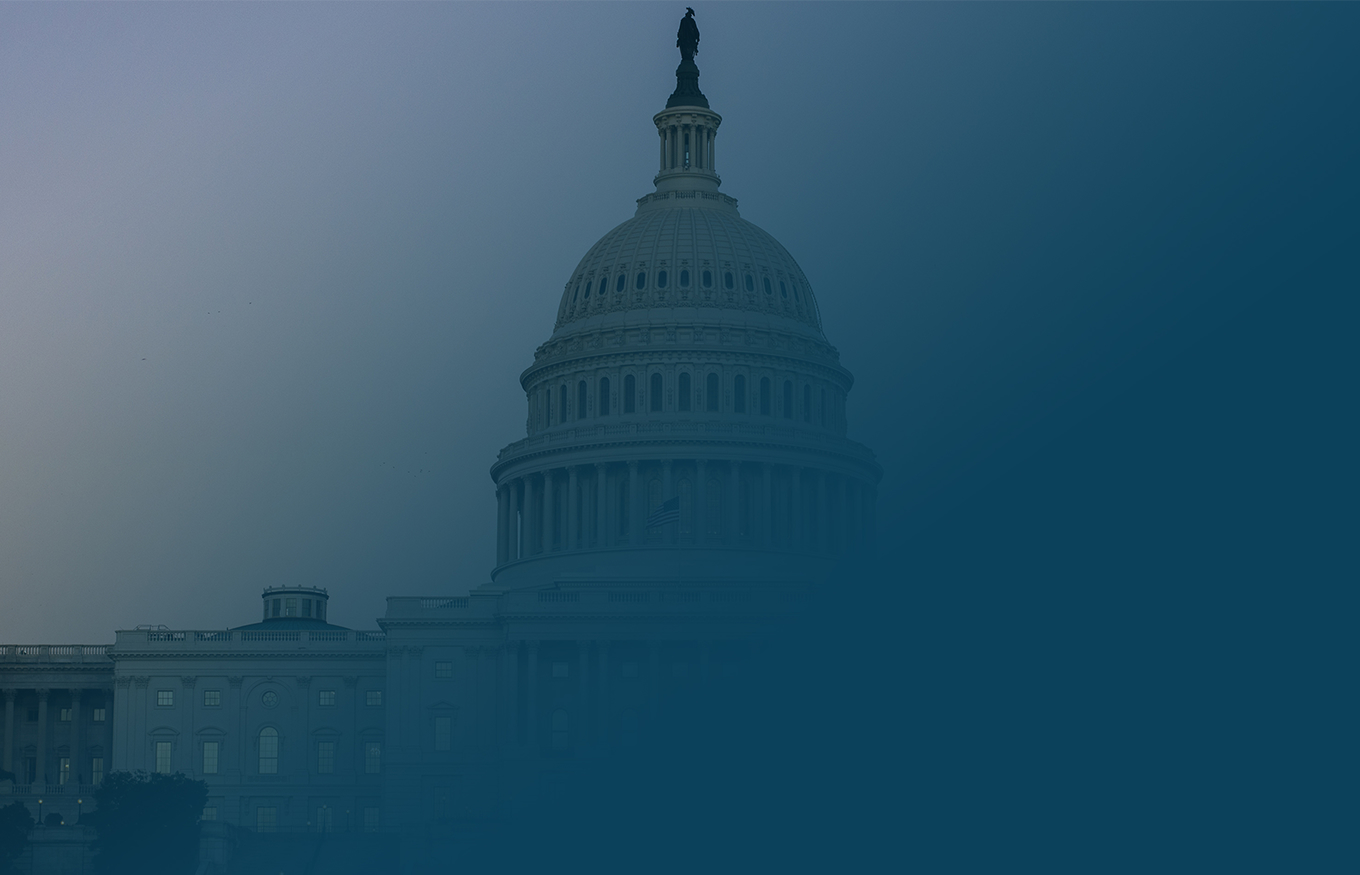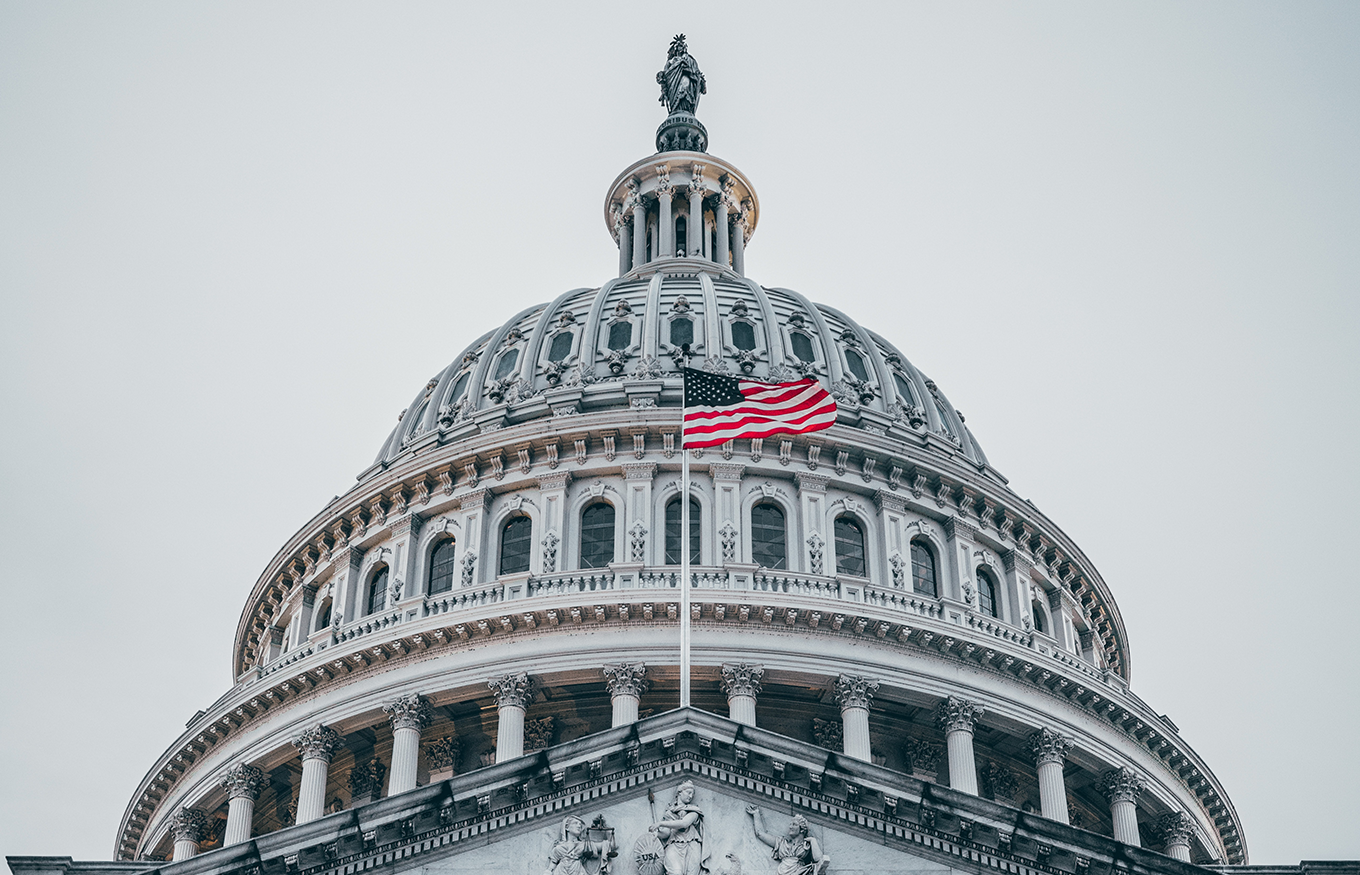
Introduction
Stark partisan dividing lines in Congress currently distract from potential areas of common ground in fostering an election system that puts voters first by being fair, accessible, secure, and transparent. These crucial topics include voter registration, voter identification, options to vote before Election Day, clean and accurate voter rolls, and audits.
This report outlines a realistic framework for bipartisan election legislation. If implemented, this framework would massively improve election administration and Americans’ voting experience.
Federal election legislation, while rare, has a long track record of being bipartisan. For as much attention as members of Congress and the public have paid to how Americans vote, the most recent comprehensive elections bill passed in October 2002. But the urgent need for shoring election infrastructure becomes more obvious with each election.
This report authored by a working group of five nonprofit think tanks elevates the election and voting reforms that have gotten lost in the highly partisan federal debate about elections. The working group comprises individuals from five nonprofit think tanks from across the political spectrum: Bipartisan Policy Center, American Enterprise Institute, Issue One, R Street Institute, and Unite America. The data used in this report is sourced from Voting Rights Lab. We came together to publish this report to ensure that important concepts—such as accessible voter registration and accurate voter rolls—are understood to be nonpartisan proposals that will improve elections and not benefit one party more than another.
Many of the policy suggestions outlined in this report draw on recommendations made by BPC’s Task Force on Elections, which includes 29 state and local election officials from 20 states devoted to making meaningful improvements to U.S. elections. The report references the task force’s recommendations made in Logical Election Policy, Improving the Voting Experience After 2020, and Bipartisan Principles for Election Audits.
The proposals in this report also align with several findings from commissions focused on U.S. democracy, including the Carter-Baker Commission, a 2005 bipartisan group that produced 87 recommendations on federal election reform that was revisited in 2021 through a series of webinars. The recommendations also track the Presidential Commission on Election Administration, a task force led by Bob Bauer and Ben Ginsberg that produced a report with recommendations for state legislative action in 2014.
Federal and State Government Roles in Elections
The current partisan debate in Congress about elections and voting overshadows the history of successful federal legislation, referenced in Appendix A, when both parties came together to improve and secure the voting experience. The federal government has acted decisively in the past to enhance access, security, and transparency in the election system and to provide funding. Congress can continue to ensure these baseline principles through consistent minimum standards backed by much-needed and regular funding for states to implement them.
In March 2020, Congress worked expeditiously to provide $400 million in urgently needed emergency election funds to states at the beginning of the COVID-19 pandemic. This funding ensured the safety and security of the 2020 election. Local and state election officials across the country need federal support now to do their jobs. It is time for Congress to provide this support.
States should take the lead on crafting voting systems that build on existing options and meet unique local needs. There are numerous examples of how election modernizations like those recommended here have been effectively and fairly used in blue, red, and battleground states. In 2021, Virginia passed a series of bills expanding early and absentee voting and improving automated voter registration and ushered in a slate of Republican officials in its next election. Importantly, states must have flexibility to implement minimum standards in ways that meet the unique needs of their voters.
Funding Elections
Elections in this country are underfunded. That reality led to an influx of private philanthropic funds in 2020. Those funds may not be coming again, and ideally should not be relied upon since funding elections is an inherently governmental responsibility.
Regular, annual federal funding is the mechanism to incentivize the adoption of the policy suggestions outlined in this report. Elections are chronically underfunded and, currently, there is no regularized funding for elections at the federal level. Federal mandates often go unfunded, which weakens legitimacy when election officials lack the resources needed to comply with federal law.
The U.S. must better fund domestic democratic processes, like elections. This working group believes that annual, federal funding tied to the minimum standards outlined below incentivizes states to implement critical election infrastructure policies, while maintaining the authority of states to administer their own elections. Tying future funding to continued implementation further incentivizes this bipartisan policy package and creates an opportunity for the federal government to contribute to the ongoing cost of elections. Finally, mandating states match federal funding demonstrates continued commitment to election infrastructure.
States that meet the federal minimum standards outlined below by 2024 should be eligible for grants accessible through the federal government. The incentive-based legislative framework, outlined below, requires investment at the federal level. For states that meet the federal minimum standards for voter registration, casting a ballot and counting the vote, the federal government should provide access to grants at the state level.
A possible formula for determining the amount of funding per state is to consider $10 per vote cast in the previous presidential election distributed over the subsequent four years. For example, if a state had 7 million ballots cast, it would receive $17.5 million each fiscal year for election administration purposes until the next presidential election resets the multiplier. This is only an example of one possibility for the federal government to fund elections.
These funding parameters are just a starting point for the discussion on how federal funding can support election administration at the state and local level. There will need to be a balance between the incentive structure necessary to encourage participation with federal budget constraints. Congress is in the best position to balance these factors.
States should match a proportion of the funds received through grants and spend grants or document a budget demonstrating a spending plan for the grants within the federal fiscal year. Federal funding incentivizes states to invest in their election processes. The grants from Congress should be matched by states, so that states demonstrate investment in their election infrastructure. This working group does not have a recommendation for the percentage of matching but trusts that Congress can decide on a number. Grants should be spent within the federal fiscal year or accounted for in a budget that demonstrates a spending plan for the grants, to keep accurate and timely records of election spending year over year. A regular, annual investment in elections by Congress demonstrates a commitment to the legitimacy and security of the voting process.
Achievable Policy Solutions
Rather than providing a one-size-fits-all federal mandate, this working group posits that the key to bipartisan compromise is through federal election funding for states that meet the minimum standards proposed in this report. To ensure that feasible federal election reform options do not get lost in the overheated partisan debate occurring in Congress, this working group identifies four key areas to reframe the conversation about federal election reform: voter registration, casting a ballot, counting the vote, and cybersecurity and physical security.
Each policy suggestion described below relies on the other suggestions and minimum standards this working group recommends. The purpose of this report is to highlight the synergy of these measures to strengthen our elections and encourage both parties to develop joint proposals in these four key areas.
Individual policy recommendations are endorsed by this group as part of a comprehensive package.
These four areas each contain suggestions that are supported by either Democrats, Republicans or both at the state or federal level. The working group believes compromise can be achieved by engaging directly with the areas with the potential for bipartisan support. As with the Help America Vote Act (HAVA) in 2002, careful negotiation and an incentive-based grant structure will be the foundation of any federal election bill that passes through Congress. Reforms in these four key areas should not make a partisan impact and will improve election administration, voter confidence, and democracy in the U.S.
Currently, Colorado and Georgia meet all the recommendations detailed in this report. Seven additional states—Alaska, Arizona, Florida, Hawaii, Rhode Island, Virginia, and Washington—meet all except one of our proposed standards. The goal would be for all states to be incentivized to meet all standards through federal grants.
This working group proposes minimum federal standards in the following key areas: voter registration, casting a ballot, counting the vote, and cybersecurity and physical security. The individual recommendations suggested in each of these areas should not be taken out of context from the greater policy area.
Percentage of Minimum Standards Met by States
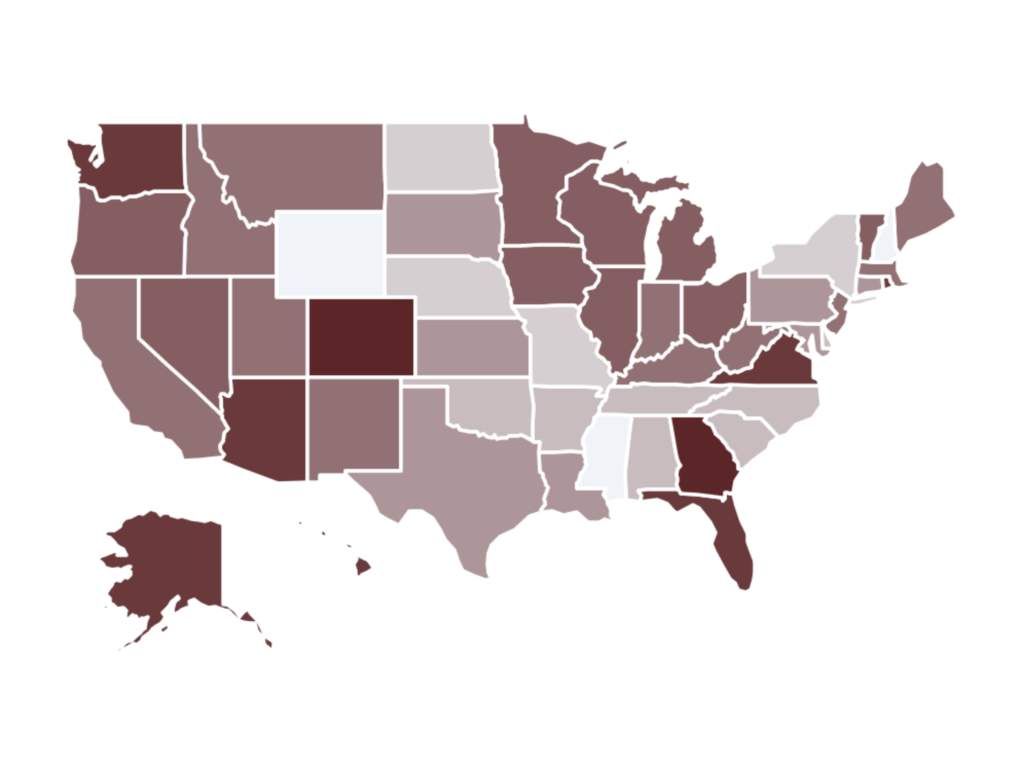
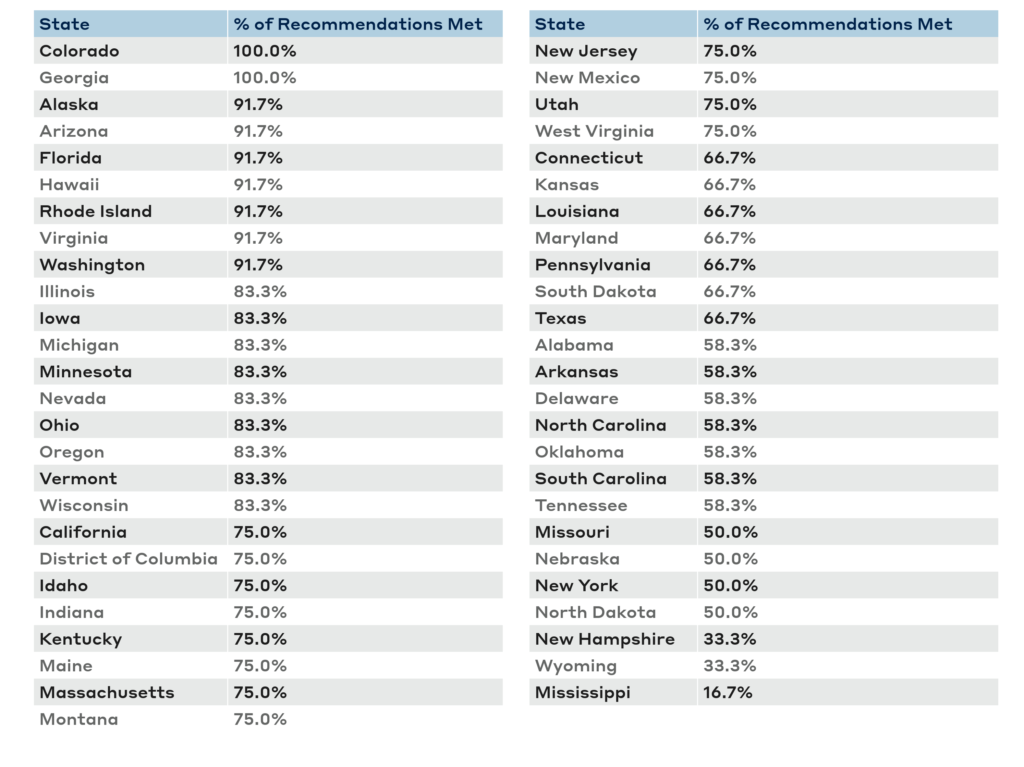
Voter Registration
Democrats and Republicans agree that accessible, secure, and reliable voter registration processes are critical to fair elections. The opportunity for voters to register to vote through state and federal agencies, like the Department of Motor Vehicles (DMV), and through online means ensures that election administrators have accurate and up-to-date voter rolls. Timely and regular voter list maintenance enhances public trust by ensuring that only eligible voters receive and cast ballots. This pairing of accessible voter registration and timely voter list maintenance addresses election priorities on both sides of the aisle.
The working group endorses the following package of federal policies to advance security and access in voter registration:
- States should be required to perform voter list maintenance at regular intervals. Regular list maintenance ensures that deceased voters are removed in a timely and efficient manner, which would dispel concerns over bloated voter rolls and fraudulent votes. Arizona, Louisiana, New Hampshire, Texas, and Utah have all passed laws with bipartisan support to expediently remove deceased voters from state voter rolls.The National Voter Registration Act (NVRA) prohibits states from removing a voter from registration rolls simply for failure to vote; however, 19 states have implemented supplemental processes to traditional list maintenance that rely on voter inactivity as an indicator to determine voter eligibility. This working group is not in agreement that voter inactivity should indicate ineligibility; however, a standardized approach to performing list maintenance addresses many of the same concerns as the supplemental processes. Conditions—including outreach to inactive voters through multiple outreach channels, not just the United States Postal Service—should be met before voters are removed from voter rolls. For voters who appear to vote at the same address after being removed, states should investigate and implement an accessible reinstatement process as appropriate.States should be incentivized by the federal government to join a multistate voter list maintenance system, such as the Election Registration Information Center (ERIC) program, for effective list maintenance. ERIC, a nonprofit run by its member states, provides a secure and accurate way for states to share voter registration and other data across state lines. For voters who move between or within states, their voter registration rolls and driver licenses can be securely shared among ERIC member states to expedite removal from their former states’ voter rolls and addition to the rolls of their new state. Currently, 30 states are members of ERIC, including Alabama, Georgia, Colorado, and Oregon.
- States should be prohibited from relying on external groups using undelivered mail to target voters for removal from voter rolls. This practice, commonly called “voter caging,” inaccurately assumes certain voters are ineligible to vote because their mail cannot be delivered to the address associated with their voter registration. It also outsources an inherently governmental function to private entities, when it is the government that should be responsible for and incentivized to maintain accurate voter rolls.“Voter caging” often occurs with partisan intentions that unfairly target minorities, voters of color, and other marginalized individuals. This practice also impacts individuals without set addresses —snowbirds, seniors living with different family members, and other seasonal or transitory workers. Basing voter registration eligibility on the assumption that voters are ineligible because their address appears to be incorrect leads to mistakes in who may be ineligible to vote. By prohibiting these campaigns, the federal government will incentivize fair and effective practices for maintaining voter registration rolls.
- States should use standard automated voter registration processes based on security best practices. The NVRA requires that states allow voter registration through the DMV. Some states have created voter registration application processes through the DMV to register voters unless an applicant declines to register to vote. This policy suggestion expands on the NVRA to include other state and federal agencies beyond the DMV, but maintains that states should allow applicants the option to opt out of registering to vote. Some form of automated voter registration (AVR) is currently implemented in 18 states and Washington, D.C., with three additional states intending to implement AVR for the next election. For states that allow AVR, the DMV and other state or federal social services agencies should seamlessly connect with designated state election offices to update voter registration. AVR benefits voters as well as election administrators by making voter registration a seamless and efficient process. With AVR, election administrators maintain cleaner voter rolls because change-of-address information transfers directly from state and federal agencies to state voter rolls.
- States’ online voter registration systems should connect to other state databases to determine voter eligibility for voters who move intrastate. Online voter registration (OVR) offers a way for voters to accessibly and easily register to vote online. It benefits election administrators by providing accurate and reliable data directly from voters themselves. Currently, 43 states and D.C. have OVR have implemented or have plans to implement OVR by the next election.

Casting a Ballot
Historically, the expansion of early voting options and voting by mail has occurred in Republican and Democratic controlled states. Texas and Tennessee were two of the earliest adopters of early in-person voting. California, Oregon, and Colorado were earlier adopters of voting by mail. The expansion of options for voters to cast their ballot is in the interest of both parties. Though our elections are secure, the implementation of a standardized minimum for verifying voter identity requirements could mitigate concerns over fraudulent voting. Pairing voter identification standards with the expansion of voting by mail and early voting options addresses both Republican and Democrat priorities to improve voter turnout and ensure fair ballot casting.
- States should adhere to a minimum requirement for verifying voter identity that includes a variety of identification options. Currently, 35 states have some form of voter identification required for voters to cast a ballot in person, including states that offer alternatives for voters who arrive without identification. By implementing a minimum standard of voter identification across states for federal elections, the federal government could appease concerns that certain states make it easy for ineligible voters to vote.Casting a ballot by mail versus at a polling place or voting center requires different identification policies because of the challenges of verifying a person’s identity when they are not in person. For mail-in ballots, signature verification, voter identification numbers, and other verification means should be explored to prioritize security and accessibility.
- Voters should have the option of voting early and in-person for a period of at least seven days in advance of a federal election. Smaller, municipality-based election jurisdictions should be allowed to join together to offer shared, convenient early voting.Currently, 38 states have at least seven days of either early voting or in-person absentee voting (although some of these states do not include consecutive days or weekends). This suggestion would only require 12 states to expand their early voting options. By increasing to at least seven days of early voting, states are given the flexibility to adapt based on jurisdiction size without compromising voter access. Voters should be able to cast a ballot before Election Day in the same manner as they would at a polling place on Election Day. For smaller municipalities, resource sharing for early voting could mitigate the burden and extra costs of early voting. Federal funding provisions to support the implementation of these minimum standards will be discussed later in this report.
- Absentee voting for all voters should be available with secure ballot tracking, a means of voter identity verification, robust ballot curing measures, and multiple return options. Currently, 33 states and D.C. offer no-excuse voting by mail, 45 states and D.C. offer online ballot tracking, and 40 states and D.C. have some remote verification policy in place for mail ballots,[1] such as identification number requirements or signature verification. By giving voters the ability to receive a ballot by mail without providing an excuse, election administrators improve the convenience of voting and give all voters more options on how to vote. Secure ballot tracking gives voters insight into the arrival and processing of their ballot, thus improving trust and confidence in democracy.The BPC Task Force on Elections endorses giving voters multiple options when choosing how to vote; however, the implementation hurdles of voting by mail include investing in new technology, expanding the timeline to process, improving the quality of voter registration lists, and an additional risk for election administrators because ballots are outside the direct control of election offices. The added risk of vote by mail prompts an emphasis on security and a prioritization by the U.S. Postal Service to ensure ballots are tracked throughout the voting cycle, as discussed later in this report.Required, secure, online ballot tracking gives voters insight into the arrival and counting of their ballot. Signature verification provides a way for election administrators to verify the identity and eligibility of the voter. With expanded return options, including robust ballot curing measures, no-excuse absentee voting provides a standardized and flexible avenue to expand voting and provide options to voters.
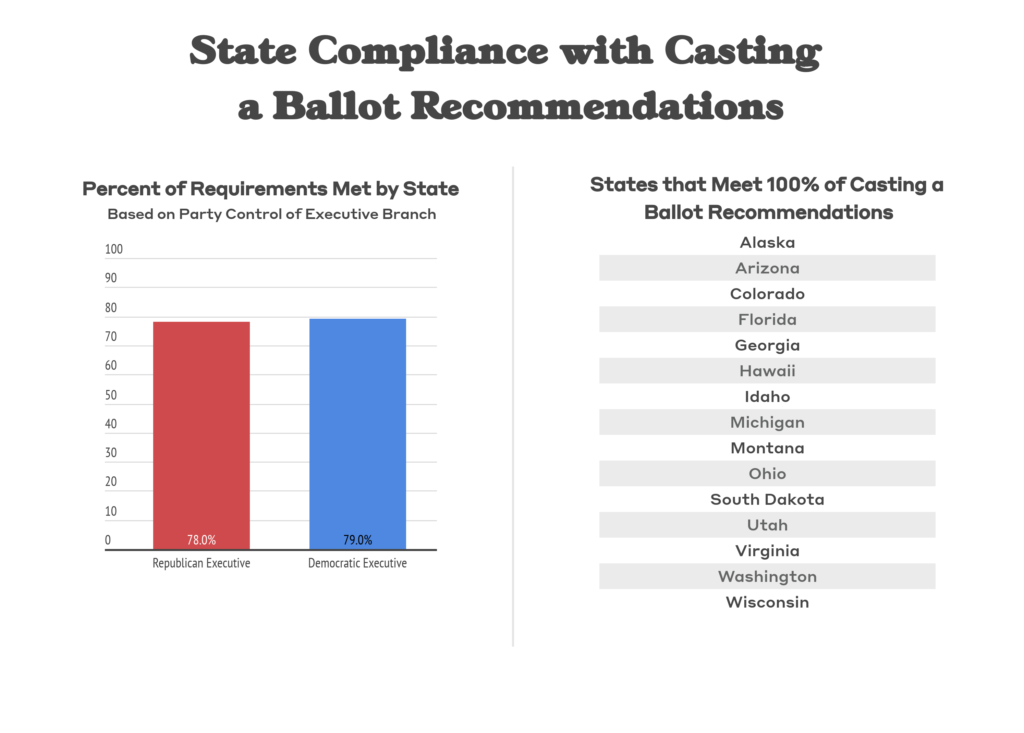
Counting the Vote
The days after an election are especially prone to misinformation as election officials continue to count and process ballots while voters demand results. The problems that occur due to the lack of standardized ballot return dates contribute to mistrust in the election system and delay the reporting of results. High demand for unofficial election results after the close of polls conflicts with the necessity for accurate and secure vote counting procedures, placing election administrators in a tug of war between speed and accuracy. Election administrators work long hours and the lack of uniformity among states, and voters’ lack of knowledge, leads to confusion among voters as to why results are delivered at widely different times across states. By addressing the lack of standardization in states’ post-election timelines and coupling this with an increased timeline for election administrators to process ballots before the election, the release of unofficial election results could become expedited and more secure.
- States should begin preprocessing vote-by-mail ballots a minimum of seven days before Election Day. Currently, 32 states and D.C. allow election officials to begin verifying vote-by-mail ballots at least seven days before Election Day. The upside to incentivizing early processing of mail ballots is that it allows more time for identity verification and ballot curing for vote-by-mail voters. It also allows election officials an improved workflow for processing ballots before and during the election, which leads to ample time for a precertification audit after Election Day. With the continued expansion of vote-by-mail options, election administrators need expanded timelines and resources to process vote-by-mail ballots.
- In every state, mail ballots should be received by Election Day at the close of the polls to be counted. As discussed above, the period between when the polls close and when unofficial results come out provides a breeding ground for mis- and disinformation that undercuts trust in elections. The differences in the postelection timeline across states have become a deeply criticized and confusing discrepancy for voters. To expedite the release of unofficial results, the federal government should encourage a standard that all ballots must be received by the close of polls on Election Day. This could address the problem of each state releasing unofficial results on a different timeline and could build back trust in the election system. Exemptions for Uniformed and Overseas Citizens Absentee Voting Act (UOCAVA) voters or for voters who are a certain distance from the canvassing site should be considered.
Currently, 32 states and D.C. already require that ballots must be received by Election Day to be counted. In 2020, ballot return procedures were the target of public speculation and disinformation campaigns. Simplifying and standardizing the process of returning vote-by-mail ballots by the close of polls could protect the elections process from the false claims made about later-arriving ballots. Increased demand among voters to receive results quickly also motivates this suggestion.This recommendation requires a well-functioning United States Postal Service (USPS) that can guarantee timely receipt and delivery. To accompany this recommendation, the working group suggests that the USPS prioritize election mail at a service level that offers ballot tracking. By formalizing the role that the USPS plays in elections and providing resources to implement ballot tracking services through the USPS, the federal government would improve the transparency and security of election mail.
- States and localities should conduct audits after each federal election. Currently, 34 states and D.C. currently perform precertification audits or audits that include a means of addressing the discrepancy; for example, through a recount. For every federal election, states and localities should be required to conduct audits of their voting system. If a post-election audit finds significant discrepancies in the original tally of the vote, there should be a process put in place to correct the result, such as a recount. If the error is due to tabulation, then the audit should result in an expansion of the audit and, ultimately, a recount of all ballots cast. For state and municipal elections, the federal government leaves it up to the state to decide whether to audit. This leaves flexibility for states to develop robust audit systems but does not mandate that an audit be conducted for every election. Precertification audits allow discrepancies to be identified prior to the certification of the vote, but finding the time to conduct an audit before the vote is certified can be challenging. BPC’s report Bipartisan Principles for Election Audits further expands on this suggestion.

Cybersecurity and Physical Security
Since the 2016 election, the federal government has begun efforts to support the cybersecurity of state and local election offices. The importance of continued cybersecurity funding and guidance in elections cannot be denied by either party. Additionally, recent threats to the lives of election officials, experienced by Republican and Democratic election officials alike, indicates the need to consider physical security with the same seriousness as cybersecurity. The following suggestions represent a combination of bipartisan cybersecurity and physical security policies that could be implemented to enhance election safety and security across the U.S.:
- The federal government should develop a program of cyber navigators that seeks to connect election officials with appropriate resources. Cyber navigators could bridge election administration with cybersecurity best practice. These would be individuals who connect election officials with the resources necessary to effectively maintain secure and agile digital systems. Cyber navigator roles would be a highly effective way of expanding and elevating an individual in state election offices with the role of keeping all jurisdictions in the state aware of cybersecurity threats and vulnerabilities. A federal mandate for these positions ensures standardization across states to effectively deliver high-level cybersecurity protections across the U.S.
- The federal government should implement minimum cybersecurity standards for state and local election offices and include comprehensive cybersecurity training, multifactor authentication and moving to the “.gov” domain. Funding for cybersecurity training for all election administrators at every level ensures that all election offices receive standardized, comprehensive training on cyber threats. A mandate for the implementation of multifactor authentication would protect vulnerable databases. Moving all jurisdictions’ websites to the “.gov” domain would ensure that voters know they are interacting with the trusted sources of information. Moving to the “.gov” domain could assist with combating false information about elections. Technical support through the Cybersecurity and Infrastructure Security Agency, combined with federal funding for cybersecurity training and implementation of best practices, would provide election offices with the support necessary to be properly secured against cyber threats.
- The federal government, in collaboration with the U.S. Election Assistance Commission (EAC) and the DOJ, should provide funding for the protection of election officials and information-sharing resources regarding threats to election officials. The current rise in threats to election officials, their staff, and their families is unacceptable. Proper legal protection includes clear guidance on who election officials should report threats to and collaboration between local, state, and federal law enforcement agencies. Election officials need to be made aware of situations where their lives may be threatened. Increased coordination to share this information with election officials can be offered through federal resources: the DOJ’s task force for election officials, the EAC, and the Election Infrastructure Information Sharing and Analysis Center. These agencies should coordinate to ensure that resources and information regarding threats reach election officials in a timely and efficient fashion. The DOJ should expand its capacity to investigate potential threats to election workers and their families. Congress needs to reexamine existing federal protections for election officials to meet today’s threats.
- The federal government should provide resources and funding for physical security and doxing training for election administrators and their staff. Election officials need to feel safe doing their jobs. Doxing is when an aggressor publicly discloses the personally identifiable information (i.e., phone number, address, etc.) of an individual with the intent to harass, threaten, or stalk them. Given the influx of threats and doxing of election officials at the state and local level, the federal government should sponsor training for how to handle death threats and ensure the safety of election administrators at all levels. This training should involve fostering lines of communication between election offices and law enforcement agencies at the local, state, and federal levels.
Current Uptake of the Standards
Georgia and Colorado already meet these election administration standards today. Seven additional states, Alaska, Arizona, Florida, Hawaii, Rhode Island, Virginia, and Washington are only missing one of these standards.
Three states—Arizona, Florida, and Hawaii—meet every standard except for automated voter registration and a full integration of their election offices with other state and federal agencies covered by the existing NVRA. Eighteen of the 50 states already meet at least 75% of these expectations.
The lowest takeup of the standards so far falls in the voter registration bucket, specifically around NVRA-related automation. Only 19 states have implemented some form of automated voter registration. Nearly 70% of states already require some type of voter identification, and nearly 75% offer early voting for at least seven days.
There are a few notable states to highlight. Kentucky meets 73% of these standards without having AVR implemented. New York state trails Kentucky, with only 55% of standards met.
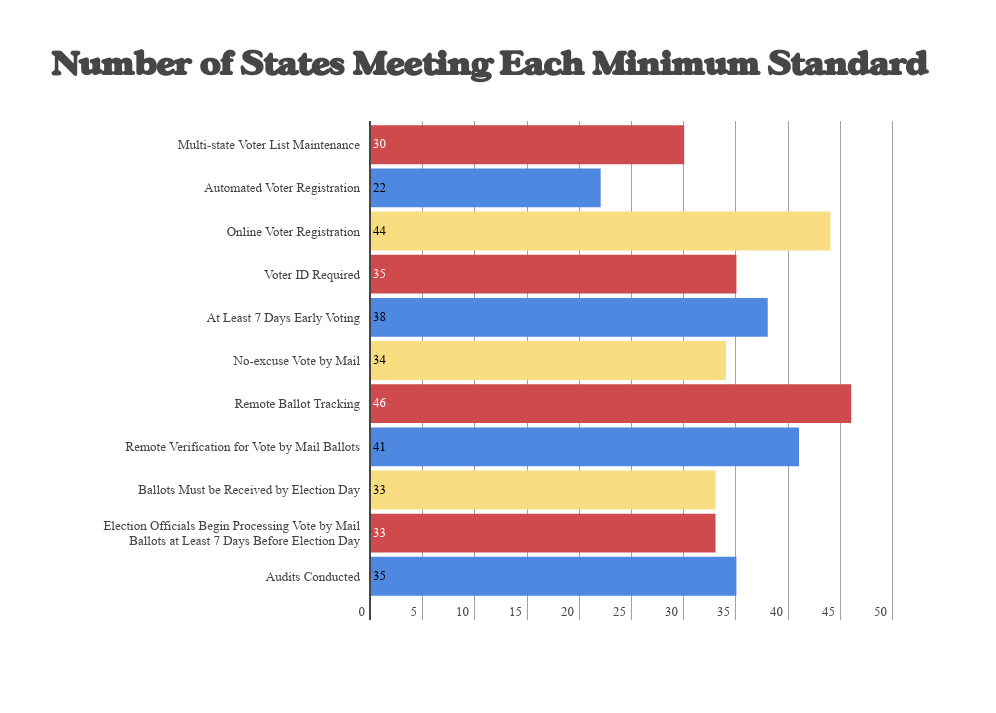
Conclusion
A federal election reform bill that provides funding to states that meet a reasonable set of minimum standards for voter registration, casting a ballot, vote counting, and cybersecurity and physical security could usher in a new, durable era in election administration. These policies would not disproportionately impact Republican or Democratic electoral prospects. Rather, it could heal partisan divides and ensure fair, accessible, secure, and transparent elections for the long term.
To instill national confidence in the fairness and security of our elections, the parties should take the first step to agree on the very basics of the mechanics of voting. Establishing a floor that all voters can understand that is achievable for election officials and respects resource constraints has the potential to significantly secure elections and improve the voting experience for years to come.
Past Federal Voting Legislation Received Significant Bipartisan Support
The Help America Vote Act of 2002 and the National Voter Registration Act of 1993 are the last two pieces of landmark election legislation to be enacted at the federal level. While hard to imagine today, both bills received significant bipartisan support, even after the 2000 election.
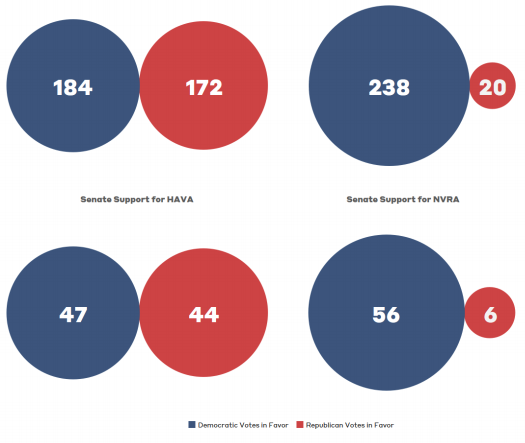
Appendix A: The Bipartisan History of Federal Voting Reform, and Appendix B: Methodology and Sources

Endnotes
[1] Please see Appendix B to view the source for this metric.
